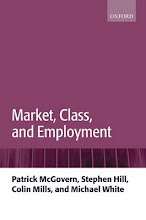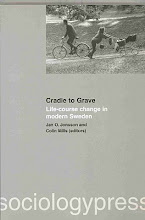If you study social mobility you are pretty much forced to study it through the rear view mirror, looking back, as it were, over your shoulder. You can of course pretend you are Mystic Meg and on the basis of what you know about how kids are doing in school take a punt at fortune telling (sorry, model based prediction) and if that's your thing good luck, you need read no further. Personally I find it hard enough to say what happened in the past and I'll leave speculation about the future to others.
But how far back should you go? That's a good question, but I'm going to substitute another: how far back can you go? "Can" here means something like: find a bunch of mobility tables that stretch back from more or less now a tolerable distance into the past, that cover roughly equivalent populations (though obviously not the same population) and can be coded into a reasonably disaggregated and harmonized set of categories.
The answer in the UK, if you are interested in social class mobility, is 1963 (other sorts of social mobility can be studied - terms and conditions apply).
I have assembled a set of 22 social class mobility tables for British men (tables for women & for households are in the pipeline) that cover the period from 1963 to 2018. All of these with the application of a little ingenuity & perspiration can be and in fact have been coded to the ONS's NS-SEC scheme. This wouldn't have been possible without the witting and in most cases unwitting help of colleagues both in Oxford and elsewhere who gave me access to, or put in the public domain, cross-walks and lookup tables that made it possible to span the decades of changing official occupational classifications. The results are not perfect but I'm as sure as I can be that diminishing marginal returns to time spent on classification set in long ago. I confess that there is one more table I could have added - the UK contribution to the 1991 International Social Justice Project - but my nerve failed when I contemplated the effort needed to render ISCO88 codes into 1990 ONS SOC codes (I know there is an ONS lookup table - but that still leaves you with work to do). It didn't seem worth it to gain a few 100 cases when I already had several data points in the early 1990s.
So I have 141,247 observations, spread, rather unevenly, over 22 7x7 tables and a lot of caveats. Because this is a blog post and not an academic article I'm not going to go into all the caveats here. Apart from anything else I'm reasonably sure they don't affect the big picture. Suffice to say that age ranges are not always entirely consistent - mostly 20-64, sometimes 20-59, occasionally 20-49 and once 30-59. The target population varies a little - mostly GB, occasionally UK and once just England. There are minor variations in how origin class is defined. You can play endlessly with all of this, leave out tables, narrow down age ranges so everything is precisely aligned and...it doesn't seem to matter. None of this forces you to revise the prima facie obvious conclusion which staring at Figure 1 suggests.
The black dots are the multiplicative parameters from a so called "unidiff" model. As time moves forward they move downwards away from 1 (the level of association in the reference table which is the pooled and reweighted data from the 1972 English and Welsh Social Mobility Inquiry, the 1973-4 Northern Irish Social Mobility Study and the 1974-5 Scottish Mobility Survey). That means that the origin-destination association decreases over time. In other words, social class mobility increases.
Maybe you don't like log-linear models, after all they are associated with those nasty Nuffield College guys and we know what they are like...OK, the red dots are the Altham index for each table. You would draw the same conclusion from looking at that...as you would from the Prais index, Frobenius' index, Yasuda's Index, Cramer's V, the contingency coefficient, the canonical correlation and Pullum's index 1 (remember that?). All agree that association declined - probably most rapidly in the 1970s and 1980s - ergo social mobility increased. The decline in association sees to have slowed down in the 1990s and may have flatlined after the turn of the millenium - but it is difficult to tell because we don't have many data points covering the last 2 decades.
But does any of this matter, or rather, how much does it matter? A rough and ready way of answering this question is to take the odds-ratios from one of the early tables - the pooled 1970s English, Northern Irish and Scottish mobility Surveys and impose them on the marginal origin and destination distributions of the latest table in my collection which comes from the pooled 2014-18 Labour Force Survey (culled from Table 3.3 of this report). This gives a counterfactual 2014-18 mobility table representing what social class mobility would have been like in 2014-18 if the level of origin-destination association had been the same as it was observed to be in the early 1970s.
Table 1 shows you the observed 2014-18 "outflow" percentages ie p(D|O) x100. There is nothing very startling about it. Table 2 shows you the percentage differences between Table 1 and the counterfactual table that would have (hypothetically) been observed if in 2014-18 origin-destination association had the strength it was observed to have in the early 1970s.
Most of the differences don't look that big - but actually in proportional terms even small differences can be significant. Broadly speaking long distance upward mobility would have been rarer as would long distance downward mobility. Probably the standout difference concerns not mobility but immobility. In the counterfactual table almost 50% of those with class 1 origins have class one destinations but in the observed table it is nearer to 40%. On the face of it this is somewhat surprising. We are told that the privileged classes habitually use all their wiles to make sure their off-spring remain in the parental social class. They, like the rest of us, like the idea of social mobility but not the idea of downward social mobility. The social changes that have increased mobility could be said to have reduced the ability of class 1 to "reproduce" itself. Why that might be will have to be a topic for a another time. But a parting thought. Could it be that the resources that are implicated in class reproduction - whatever these may be - are no longer as correlated with social class membership as they used to be (assuming that all of this isn't just some sort of measurement error induced illusion)?














